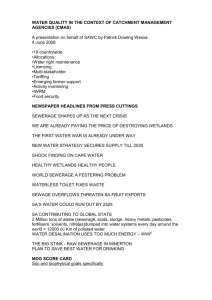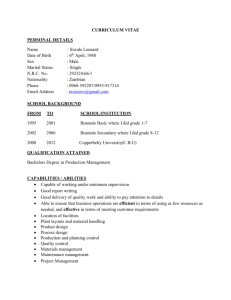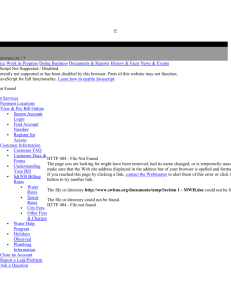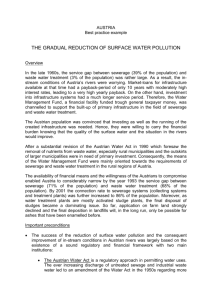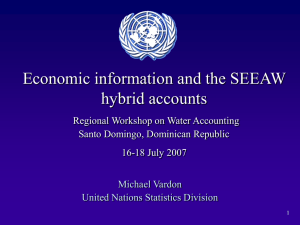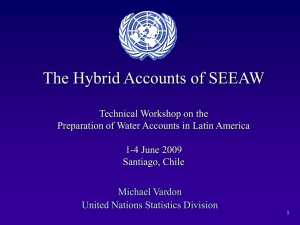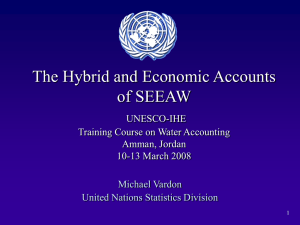Valuing Water: Monetary Water Accounts as a First Step June 2006
advertisement
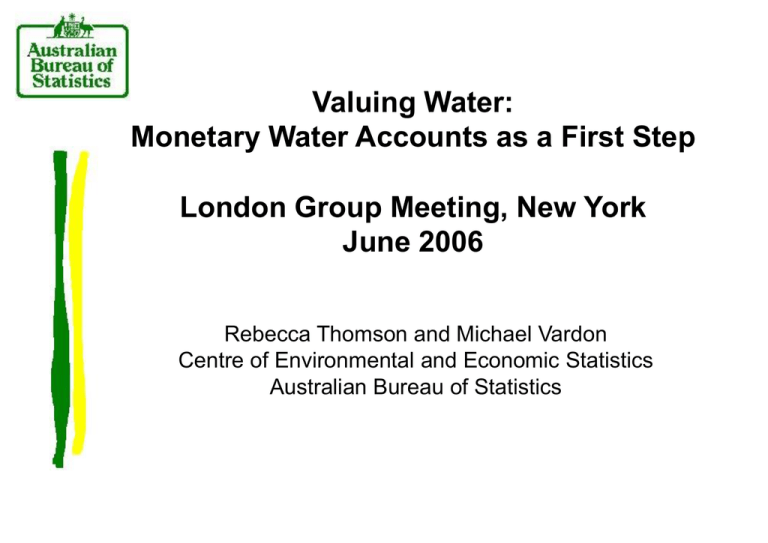
Valuing Water:
Monetary Water Accounts as a First Step
London Group Meeting, New York
June 2006
Rebecca Thomson and Michael Vardon
Centre of Environmental and Economic Statistics
Australian Bureau of Statistics
Presentation outline
1. What are the issues to do with water
valuation?
2. Why are monetary accounts useful
3. Experimental monetary accounts
•
Methods and results
4. Key data issues
The issues and
• The classification of water and water related assets,
products and industries
• Practical problems
–
–
–
–
–
Water pricing and zero resource rents
“Thin” and imperfect markets for water trading
Valuation of flood damage?
Who owns the rain?
Data availability and data quality
• Subdivision of water supply industry
– Rural, primarily for agricultural use
– Urban, primarily for household and industrial (nonagricultural) use
– Size categories (e.g. volume supplied and/or number of
agents serviced)
Water and Water Related Assets
1. Water supply infrastructure
2. Water application and management infrastructure
(e.g. flood mitigation works, sprinklers)
3. Water administrative/economic instruments
4. The water itself e.g. distributed water (wholesale
and retail), re-use (=grey) water, surface water,
ground water and rain water
(Also current and capital EPE, eg for sewerage plants)
Why monetary accounts are useful
• Reveal information necessary to calculate the value of
the water itself (ie. Net Present Value)
• Enable the economic costs and benefits of water supply
to matched with physical data on water stocks and
flows. Costs and benefits can occur:
– Now/later
– Here/there
– Public/private (and between industries), especially public
water supply and private agricultural water use
• Assists with resource allocation decisions and the
selection of policy instruments needed to achieve
optimal/efficient allocations
Water use in Australia and
scope of monetary account
Selfextracted
(GL)
Agriculture
Distributed
Water
(GL)
Reuse
Water
(GL)
InStream
(GL)
Water
Consumption
(GL)
9,132
7,105
423
Mining
480
49
5
Manufacturing
296
554
16
866
Water Supply
12,767
1,768
23
1,793
Electricity and Gas
49,116
123
5
47,544
1,688
All other industries
544
1,099
45
368
1,320
96
2,086
72,431
12,784
Households
Total
16,660
127
401
2,181
517
48,039
24,909
Methods:
Classification of products and assets
Four products were selected for revenue/expenditure data:
1.
2.
3.
4.
Urban distributed water
Rural distributed water
Bulk water
Wastewater/sewerage services
Three assets selected for asset values:
1. Urban water supply infrastructure assets;
2. Urban sewerage infrastructure assets; and
3. Irrigation and drainage infrastructure assets
Methods:
Primary data sources and reference year
Supply side:
• ABS Economic Activity Survey
• State government, industry association and company
annual reports
Use Side:
• Households: State government reports, WSAA facts
• Agriculture: Water Use on Australian Farms
• Other industries: Economic Activity Survey
• Sewerage services: Environmental Protection
Expenditure Account 1996-97
Reference year: 2003-04
Supply table, 2003-04
Urban water
Rural water
Bulk water - urban
suppliers
Bulk water - rural suppliers
Wastewater/sewerage
services
Total
NSW&ACT
$'000
1,250,162
64,504
SA
$'000
434,819
18,701
WA
$'000
335,752
24,524
TAS
$'000
74,921
1,288
84,572
5,505
0
0
0
0
34,811
0
1,243,795
783,225
563,205
2,724,181 1,589,572 1,988,988
260,763
714,283
402,562
762,838
69,451
180,471
125,720
40,000
VIC
QLD
$'000
$'000
526,225 1,250,162
115,680
85,544
158,822
5,619
NT
TOTAL
$'000
$'000
61,101 3,283,454
0 310,241
0
0
403,925
51,124
26,903 3,349,904
88,004 7,398,649
Use table, 2003-04
Urban
water
$'000
Agriculture Forrestry & fishing
Manufacturing
Mining
Electricity & gas supply
Water supply, sewerage & drainage
Construction
Wholesale & retail trade
Accommodation, cafes & restuarants
Transport & storage
Finance, property & business services
Government administration
Education
Health & community services
Cultural, recreational & personal services
Total intermediate consumption
Final consumption - by households
Exports
Total
110
234,900
45,800
58,500
2,100
28,250
114,500
165,000
224,238
239,802
49,660
34,200
52,297
116,567
1,365,924
1,917,530
0
3,283,454
Wastewater &
Rural water Bulk water sewerage
Total
$'000
$'000
$'000
$'000
292,241
9,940
2,000
4,460
220
308,861
1,380
0
310,241
455,049
455,049
0
0
455,049
15,112
239,756
56,931
48,112
12,083
28,822
112,327
163,339
223,776
239,655
50,665
35,708
53,355
113,926
1,393,567
1,956,336
0
3,349,904
307,463
484,596
104,731
111,072
469,452
57,072
226,827
328,339
448,014
479,457
100,325
69,908
105,652
230,493
3,523,401
3,875,246
0
7,398,648
Household expenditure table, 2003-04
NSW &ACT VIC
QLD
SA
WA
Urban water ($000)
733,283 350,239 365,412 202,944 194,668
Population 30 June 2004 ('000)
7,055.3 4,972.8 3,882.0 1,534.3 1,982.2
Expenditure per capita ($)
104
70
94
132
98
Number of households 2004 ('000)
2698.8 1911.1 1498.1 633.1
782.8
Expenditure per household ($)
272
183
244
321
249
TAS
NT
Total
43,053 27,932 1,917,530
482.1 199.9 20,108.6
89
140
95
197.3
55.2
7,776.4
218
506
247
Asset table, 2003-04
NSW&ACT
$'000
VIC
$'000
QLD
$'000
SA
$'000
WA
$'000
TAS
$'000
NT
$'000
TOTAL
$'000
Water infrastructure
assets
12,773,806
4,943,424
5,379,458 4,859,051 2,948,958
774,518 359,816 32,039,031
Wastewater/sewerage
infrastructure assets
15,231,224
5,113,648
6,685,471 3,577,688 3,582,972
625,580 113,141 34,929,723
Irrigation and drainage
assets
Total
761,046 2,609,509 1,976,465 328,953 297,000
48,266
0 6,021,239
28,766,076 12,666,581 12,361,214 8,765,691 6,828,930 1,448,364 472,957 71,324,613
Results for 2003-04
• Total output of water & sewerage services in
was $7.4 billion, of which;
• sewerage services generated $3.4 billion;
• urban water sales generated $3.3 billion;
• bulk water sales $0.5 billion; and
• sales of rural water were worth $0.3 billion
• NSW generated the most revenue at $2.7 billion
• Total assets $71.3 billion
Monetary v physical use (%)
Households
Other
Transport and storage
Electricity and gas
Finance, etc
Manufacturing
Agriculture
0
20
40
60
80
Key data issues
• Macro accounts v. micro level statistics
• Differing classifications use in water supply industry
(Water Accounting v water accounting)
• Frequency of collection/reporting
• Repeatability of collection/reporting
• Accuracy and precision (±0.1%, 1.0% or 10%)
• Data access
• Level and change v. cause and effect (ie aggregates v
micro data for research)
• Perfection v. realistically deliverable
• Degree possible v. degree necessary
